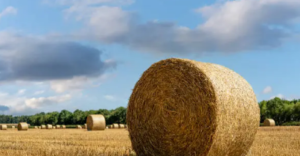Baler twine is a cost-effective substitute for wire in some situations. It can also be recycled for additional income.
Youtuber One Lonely Farmer recently conducted a test with his baling machine to compare virgin blue, black and recycled twine. He found that the Black Label Twine – recycled – performed very well in his machinery without presenting any mechanical problems. For more information about the baling twine specifications, click here.
 Tensile Strength
Tensile Strength
Twine used to bind round bales of hay or other fibrous material is available in several colours, strengths, and materials. Traditional sisal twine is still widely used, but artificial polypropylene baling twine is also standard.
The tensile strength of twine refers to how much weight it can hold before breaking. It relates to the knot strength of the twine as well.
Most balers use a Deering or Cormick-type knotter to tie their twine around the bales. The type of knotter significantly impacts how strong twine is because the type of knots made tend to have a smaller surface area, meaning they don’t allow as much slipping within the knot. It translates to a more significant overall tensile strength for the twine.
Knot Strength
The type of knot that a baler makes also significantly impacts the strength of twine. For example, a knot made in a Cormick-style knotter will retain up to 70% of the tensile strength of the twine. It is a huge difference, and it changes the accuracy of information provided by producers when quoting the ‘knot strength’ of their twine unless full details are provided on which type of knotter the product was tested under. For more information about the baling twine specifications, click here.
Big balers have two specific market users: those who make average-density big square bales, which usually use ‘Type 150’ twine, and those who make high-density bales where maximum bale weight is important, who tend to prefer the more muscular ‘Type 130’ twine. It is because the stronger twine allows the baler operator to work with thinner twine for more kilometres before it runs out.
Weight
Twine used in round balers is typically polypropylene and can come in various colours. Coloured twine can help you easily track each bale by paddock, field or person who cut it.
Today, the weight of the twine is a more relevant specification for baler users. Especially for big round balers, it’s essential to know that the twine is not overly heavy, as it can cause problems in the machine. Besides, the heavy twine can also be a strangling risk for wildlife and livestock.
Durability
Most used twine ends up in landfills or is burned. However, burning baling twine isn’t only environmentally unfriendly; it can also be dangerous for domestic animals and wildlife. It can choke or kill cattle by creating an indigestible ball in their stomach and strangle birds that get it wrapped around their necks.
The twine you buy must be a quality product to ensure the smooth operation of your baler. Look for a manufacturer who correctly describes the runnage (the number of meters per pack). Some manufacturers quote 130m for every 2kg of twine, whereas others offer only 115m. For more information about the baling twine specifications, click here.
Colour
Generally, baling twine is dyed to give it the desired colour and stabilised using UV additives to provide the duration and durability required for the application. Different twines will have different amounts of additives to achieve this and can vary in colour and strength depending on the intended use.
Unipak twine is formulated explicitly for big square baling applications, providing an outstanding relationship between knot strength and yardage. It is available in different strengths for key bale sizes and types. Their range of modern twine is segmented to match baling conditions and can be easily identified by a ‘rainbow’ icon on the pack.
Tie down things around the barn and field with this durable twine, or keep some handy to tie up recyclable waste to make it easier to transport to recycling stations.